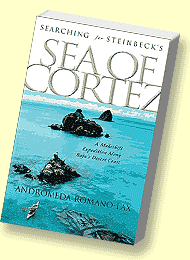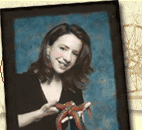|

“We
decided to read The Pearl aloud one afternoon as we sailed. The
kids listened eagerly. So did our captain, Doug.”
|
|
John
Steinbeck was inspired to write one of his most famous stories,
The Pearl, after visiting La Paz. He heard the folktale in Baja,
briefly summarized it in the Log, then spun it into a book-length
parable a few years later. The legend of the pearl was just one
of many things he took away from the Cortez — one of the stories,
settings and symbols that fed his later work for a decade.
We decided to read The Pearl aloud one afternoon as we sailed. The
kids listened eagerly. So did our captain, Doug. Brian and I had
read this story many years before — the story about the great
pearl, how it was found and how it was lost only after it had torn
a hole in the lives of a simple Indian family. On first reading,
it had seemed overdramatic and outdated. Now, we read it in Baja
and it seemed less an overwrought parable than a starkly realistic
account.
As always, Steinbeck took great care to describe his natural setting:
the Baja he came to know well in 1940. In many ways it was the same
Baja we’d been sailing and walking and tidepooling for weeks.
“The beach was yellow sand, but at the water’s edge a
rubble of shell and algae took its place. Fiddler crabs bubbled
and sputtered in their holes in the sand. ... Spotted botete, the
poison fish, lay on the bottom of the eel-grass beds, and the bright-colored
swimming crabs scampered over them.”
Aryeh, age 5, and Tziporah, barely 2, nodded — crabs, yes,
and botete. Harry Potter, our other read-aloud, was fantasy. This
was life. For young Tziporah especially, whose toddler memories
barely held for more than a week or two before blending or fading,
the setting seemed like everything she had ever known.
In the story, Kino finds an enormous perfect pearl, “the Pearl
of the World.” First it attracts friends: the doctor who will
treat their ailing son now that the Indian family has credit, and
the priest who will finally marry poor Kino to his common-law wife
Juana. But these are only false friends. The pearl arouses envy.
It leads to discontent and violence. The town’s pearl appraisers,
in collusion, refuse to offer Kino a fair price for the treasure.
Men arrive in the dark of night to steal it. This gift from the
gods, which should have bought Kino happiness and health and leisure,
instead robs him of friendship and security. It threatens his family,
muting the happy little “Song of the Family” which runs
like a current through the story.
“All manner of people grew interested in Kino — people
with things to sell and people with favors to ask. ... The essence
of pearl mixed with essence of men and a curious dark residue was
precipitated.”



Steinbeck, whose The Grapes
of Wrath had become a recent bestseller — attracting death-threats
and notoriety — had seen how new wealth and fame could drown
out the sweet, simple “Song of the Family.” Kino had struck
Juana when she tried to get rid of the poisonous pearl; John had
alienated and cheated on his wife, Carol. In Baja, Steinbeck was
still mulling over all he had lost and all that he soon would lose,
so that when he heard the parable of the Pearl it stuck to him like
a cactus burr, implanting itself in his imagination. At the end
of Steinbeck’s story, Kino reclaims his life by throwing the
Pearl of the World back into the ocean. The treasure that was never
meant to be sinks under the waves, rejected. Steinbeck tried to
do the same thing with his fame. While Grapes still dominated the
bestseller charts, Steinbeck turned away from fiction and headed
south to Baja, to write The Log from the Sea of Cortez — a
very different kind of book.
These parallels fascinated Brian and me. But Aryeh and Tziporah
were intrigued by a different aspect of the story — the very
beginning. The Pearl opens in cinematic style With the “camera”
fixed on Kino and his awakening family. As Kino opens his eyes to
the dawn light, his eyes become the lens, panning across the simple
brush hut to observe his dark-eyed wife Juana. Kino looks to the
hanging box where his baby son, Coyotito, sleeps. The Indian couple
proceeds silently with their morning routine. The sun warms the
brush house, “breaking through its crevices in long streaks.”
Then one of those streaks falls upon the ropes of Coyotito’s
hanging basket. A tiny movement there on the ropes draws Kino’s
and Juana’s attention. They freeze.
The scorpion moves down the rope toward the baby box. Under her
breath, Juana utters an ancient magic spell and then on top of it,
just for good measure, a Hail Mary. Kino glides toward the box and
reaches for the scorpion. The scorpion, sensing danger, stops, and
its tail rises up over its back in little jerks and the curved thorn
on the tail’s end glistens.
As we read the story aloud in the Zuiva’s cabin, Aryeh and
Tziporah leaned forward on their bunks, both wanting and not wanting
to hear its resolution. “And then what?” Aryeh asked.
“And at that moment,” I read quickly, trying to get the
worst of it behind us, “the laughing Coyotito shook the rope
and the scorpion fell.”
The scorpion stung the baby. A collective moan filled the Zuiva’s
small cabin. A few paragraphs later, the danger was spelled out
clearly: “An adult might be very ill from the sting, but a
baby could easily die from the poison. First, they knew, would come
swelling and fever and tightened throat, and then cramps in the
stomach, and then Coyotito might die if enough of the poison had
gone in.”
I looked up to see Aryeh and Tziporah’s expressions. Both of
them looked a little queasy, with parted lips and wrinkled brows.
But that was not the end of the story. The baby was treated quickly
and did not die from the scorpion sting. Which was lucky for us
and our delicate audience. We all could exhale.
Buy
it
Read
more:
|










